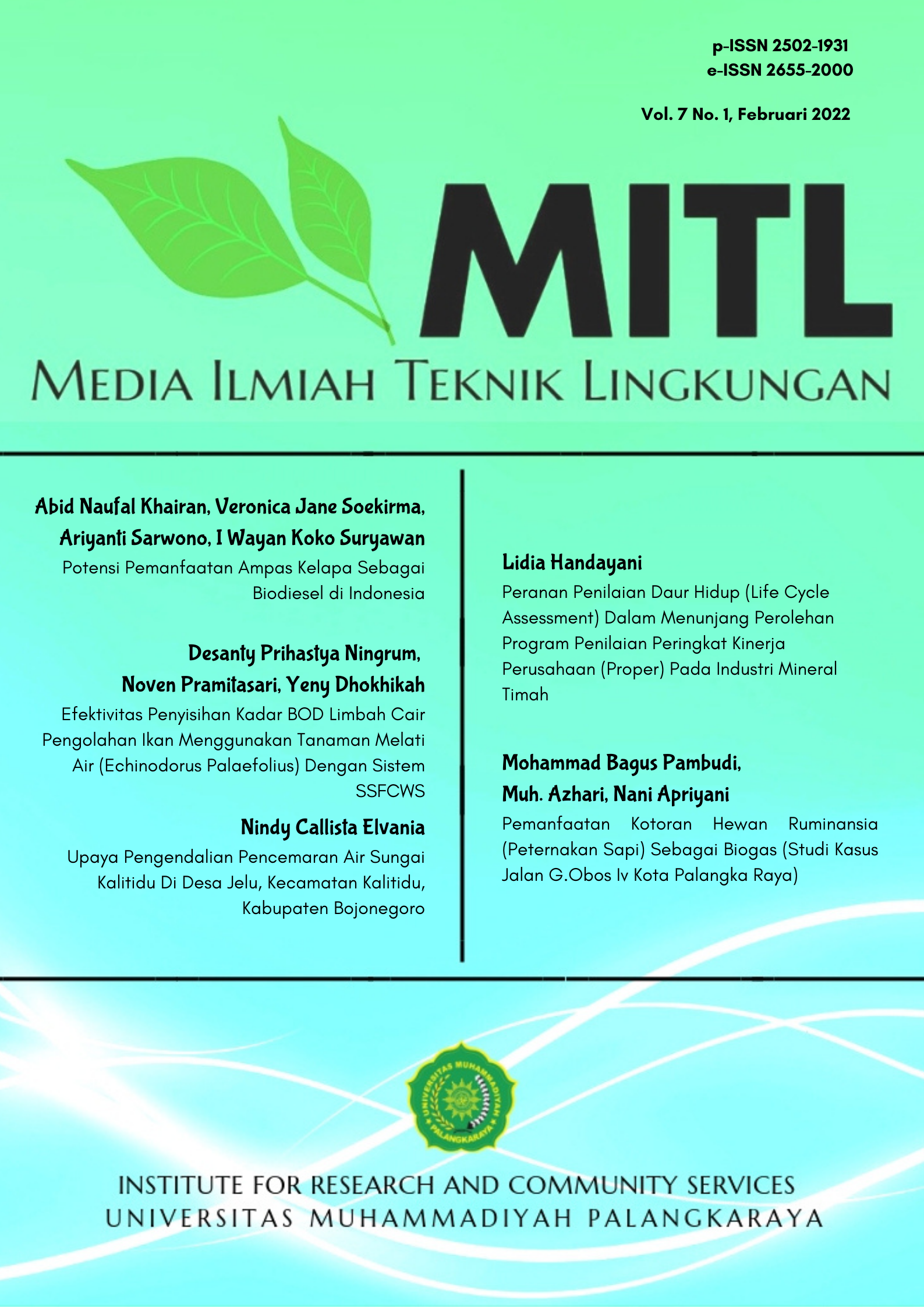Potensi Pemanfaatan Ampas Kelapa Sebagai Biodiesel di Indonesia
Main Article Content
Abstract
The potential for the use of coconut pulp as biodiesel fuel in Indonesia is very large because Indonesia is one of the largest coconut producing countries in the world. One of the conversion methods used to convert coconut pulp into biodiesel is the transesterification method using various catalysts. Based on several literature studies conducted, the yield produced using a CaO catalyst is 96.43% and using a KOH catalyst can reach up to 98.23% with the help of a microwave. The results of a survey that has been conducted on 30 grated coconut traders in various markets, the average coconut pulp produced every day is 20 kg/seller/day. The potential of biodiesel produced from the average amount of coconut dregs can reach up to 3.04 L using a KOH catalyst.
Downloads
Article Details
All rights reserved. This publication may be reproduced, stored in a retrieval system, or transmitted in any form or by any means, electronic, mechanical, photocopying, recording.
References
[2] A. G. Adeniyi, K. S. Otoikhian, J. O. Ighalo, and I. A. Mohammed, “Pyrolysis of Different Fruit Peel Waste Via a Thermodynamic Model,” ABUAD J. Eng. Res. Dev., vol. 2, no. 2, pp. 16–24, 2019, [Online]. Available: www.ajerd.abuad.edu.ng/16.
[3] I. V. A. Y. Septiariva and I. W. K. Suryawan, “DEVELOPMENT OF THE WATER QUALITY INDEX ( WQI ) AND HYDROGEN SULFIDE ( H 2 S ) FOR ASSESSMENTS AROUND THE SUWUNG LANDFILL , BALI ISLAND,” vol. 16, no. 4, pp. 137–148, 2021.
[4] J. K. Sarkar and Q. Wang, “Different Pyrolysis Process Conditions of South Asian Waste Coconut Shell and Characterization of Gas, Bio-Char, and Bio-Oil,” Energies , vol. 13, no. 8. 2020, doi: 10.3390/en13081970.
[5] A. G. Adeniyi, D. V. Onifade, J. O. Ighalo, and A. S. Adeoye, “A review of coir fiber reinforced polymer composites,” Compos. Part B Eng., vol. 176, p. 107305, 2019, doi: https://doi.org/10.1016/j.compositesb.2019.107305.
[6] N. Alias et al., “Thermogravimetric analysis of rice husk and coconut pulp for potential biofuel production by flash pyrolysis,” Malaysian J. Anal. Sci., vol. 18, no. 3, pp. 705–710, 2014.
[7] N. S. Mohamad Aziz, A. Shariff, N. Abdullah, and N. Mohamed Noor, “Characteristics of coconut frond as a potential feedstock for biochar via slow pyrolysis,” Malaysian J. Fundam. Appl. Sci., vol. 14, no. 4, pp. 408–413, 2018, doi: 10.11113/mjfas.v14n4.1014.
[8] I. M. Aditiya, “Ternyata, Indonesia adalah Negara Penghasil Kelapa Terbesar di Dunia,” 2020. www.goodnewsfromindonesia.id: https://www.goodnewsfromindonesia.id/2020/10/10/ternyata-indonesia-adalah-negara-penghasil-kelapa-terbesar-di-dunia.
[9] A. R. Maulana and T. M. Setyoningrum, “Pembuatan Biodisel dari Ampas Kelapa dengan Metode Transesterifikasi In-Situ dan Katalis Kalsium Oksida,” Eksergi, vol. 16, no. 1, p. 13, 2019, doi: 10.31315/e.v16i1.2526.
[10] L. Maurina, M. Marwan, and M. D. Supardan, “Produksi Biodiesel dari Ampas Kelapa (Coconut Waste) Secara Transesterifikasi In Situ Menggunakan Bantuan Gelombang Mikro,” J. Rekayasa Kim. Lingkung., vol. 12, no. 2, p. 62, 2017, doi: 10.23955/rkl.v12i2.8480.
[11] K. Nasruddin and D. Syahputra, “Pengolahan Ampas Kelapa Dalam Menjadi Biodiesel Pada Beberapa Variasi Konsentrasi Katalis Kalium Hidroksida (KOH),” J. Samudera, vol. 9, no. 2, pp. 78–92, 2015.
[12] A. Rahman, I. W. K. Suryawan, A. Sarwono, N. L. Zahra, and Z. M. Faruqi, “Estimation of biodiesel production from used cooking oil of university cafetaria to support sustainable electricity in Universitas Pertamina,” IOP Conf. Ser. Earth Environ. Sci., vol. 591, no. 1, 2020, doi: 10.1088/1755-1315/591/1/012013.
[13] D. Syahputra, Pembuatan dan Analisis Mutu Biodiesel Ampas Kelapa Dalam Menggunakan Katalisator Kalium Hidroksida (KOH). Aceh Utara: Universitas Malikussaleh, 2015.
[14] G. M. Mardiatmoko and Ariyanti, Production of Coconut Plants (Cocos nucifera L.). Kota Ambon: Badan Penerbit Fakultas Pertanian Universitas, 2018.
[15] S. Sulaiman, A. R. Abdul Aziz, and M. K. Aroua, “Optimization and modeling of extraction of solid coconut waste oil,” J. Food Eng., vol. 114, no. 2, pp. 228–234, 2013, doi: 10.1016/j.jfoodeng.2012.08.025.
[16] E. Suarna, “ANALISIS PEMANFAATAN BIODIESEL TERHADAP SISTEM PENYEDIAAN ENERGI,” Strateg. Penyediaan List. Nas. Dalam Rangka Mengantisipasi Pemanfaat. PLTU Batubara Skala Kecil, PLTN, Dan Energi Terbarukan, no. 16, pp. 87–100.
[17] T. R. Alkas and Norma., POTENSI LIMBAH AMPAS KELAPA SEBAGAI SUMBER BIODIESEL. Samarinda: Politani Samarinda, 2016.
[18] L. Fitriana and I. H. Purnama, Pengaruh perbandingan minyak/metanol dan waktu reaksi terhadap hasil biodiesel dengan metode sonikasi berbahan baku ampas kelapa dengan katalis CaO, vol. 53, no. 9. Surakarta: Universitas Muhammadiyah Surakarta, 2019.
[19] A. A. A. Raksodewanto Mokhammad; Hariana, Hariana, “Penggunaan Biodiesel B30 Untuk Sektor Pembangkit Listrik Dalam Rangka Penghematan Devisa,” Pros. Semnastek, no. PROSIDING SEMNASTEK 2018, pp. 1–5, 2018, [Online]. Available: https://jurnal.umj.ac.id/index.php/semnastek/article/view/3538.
[20] R. Raksasat et al., “Blended sewage sludge–palm kernel expeller to enhance the palatability of black soldier fly larvae for biodiesel production,” Processes, vol. 9, no. 2, pp. 1–13, 2021, doi: 10.3390/pr9020297.
